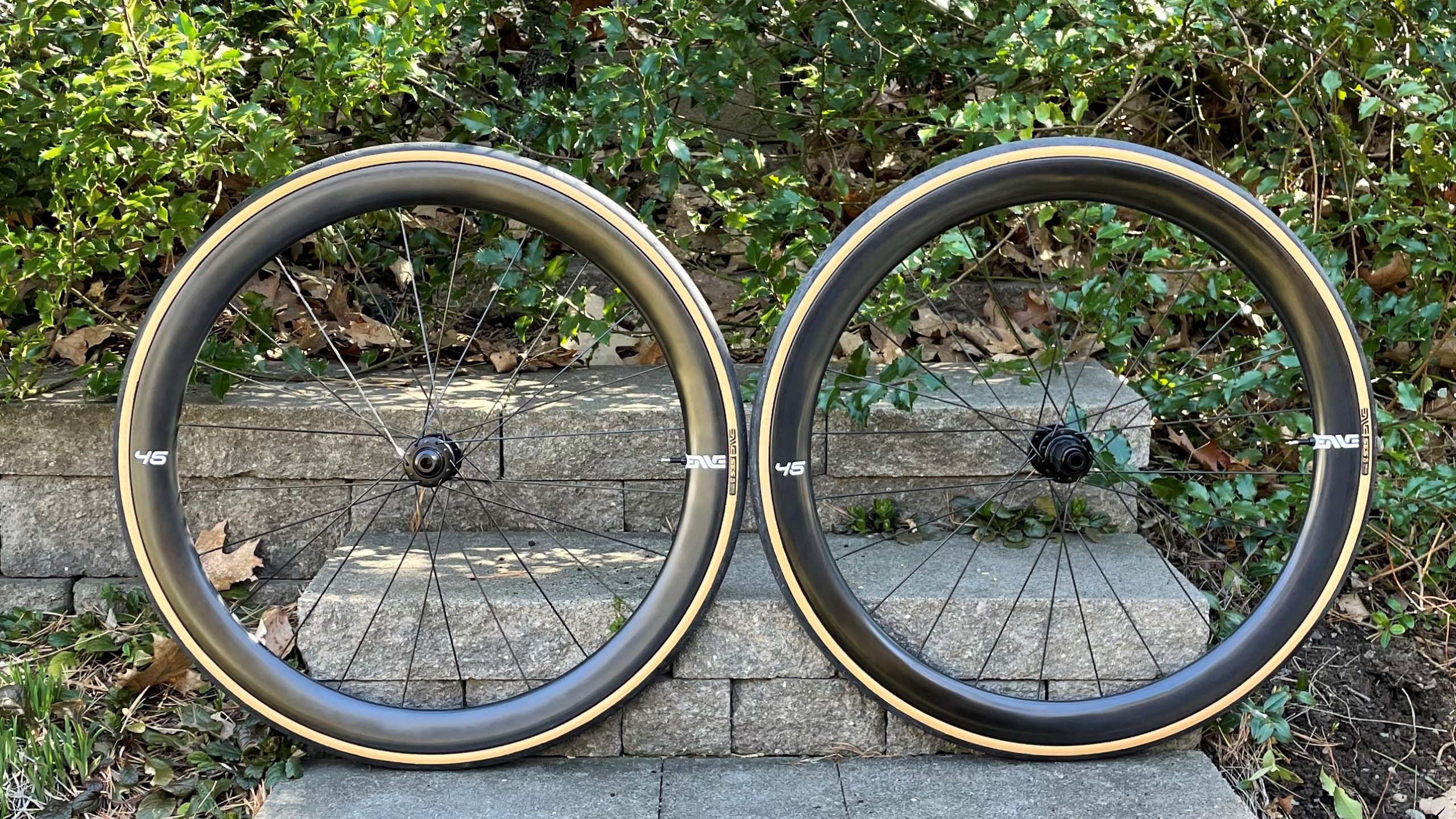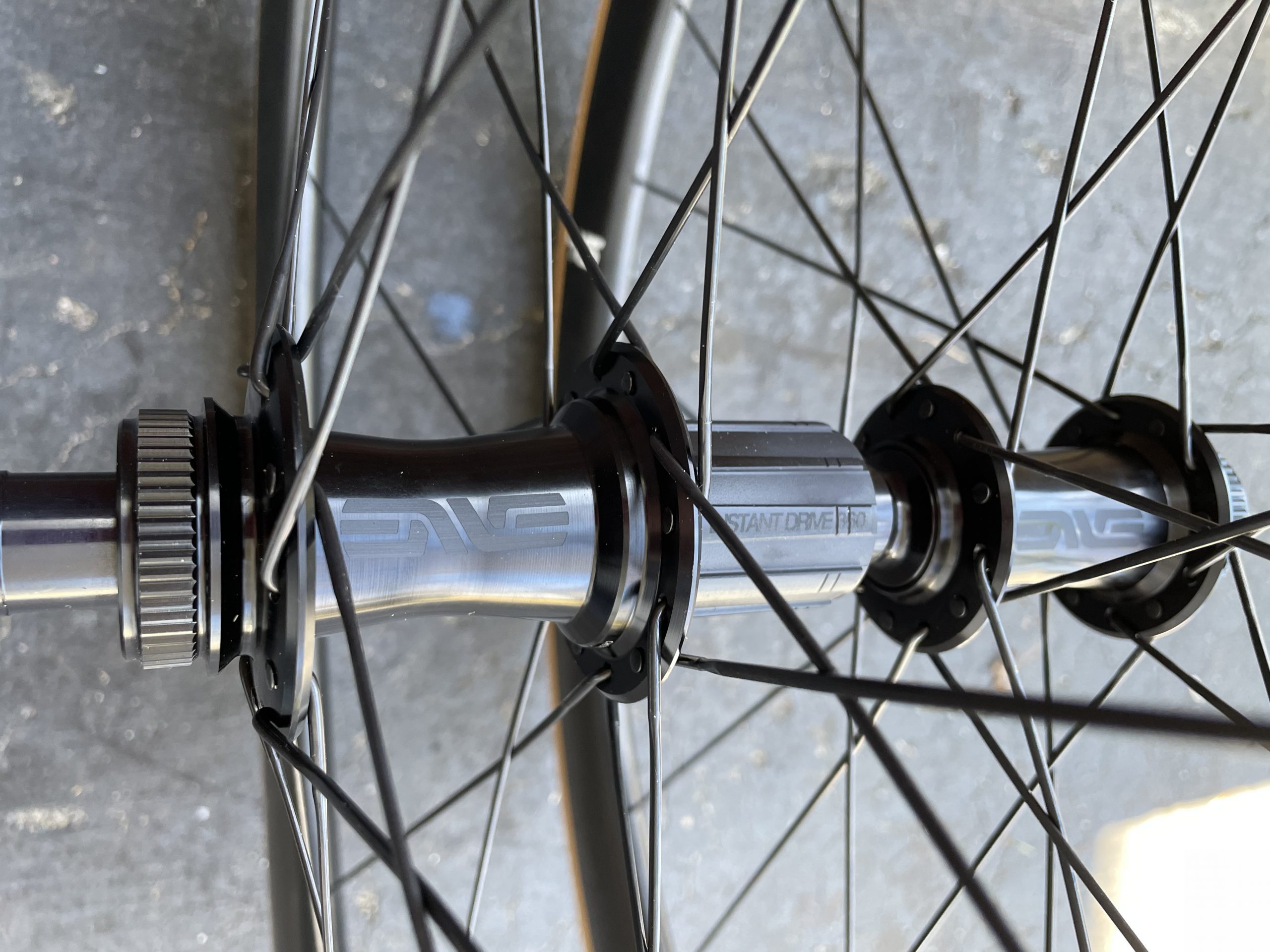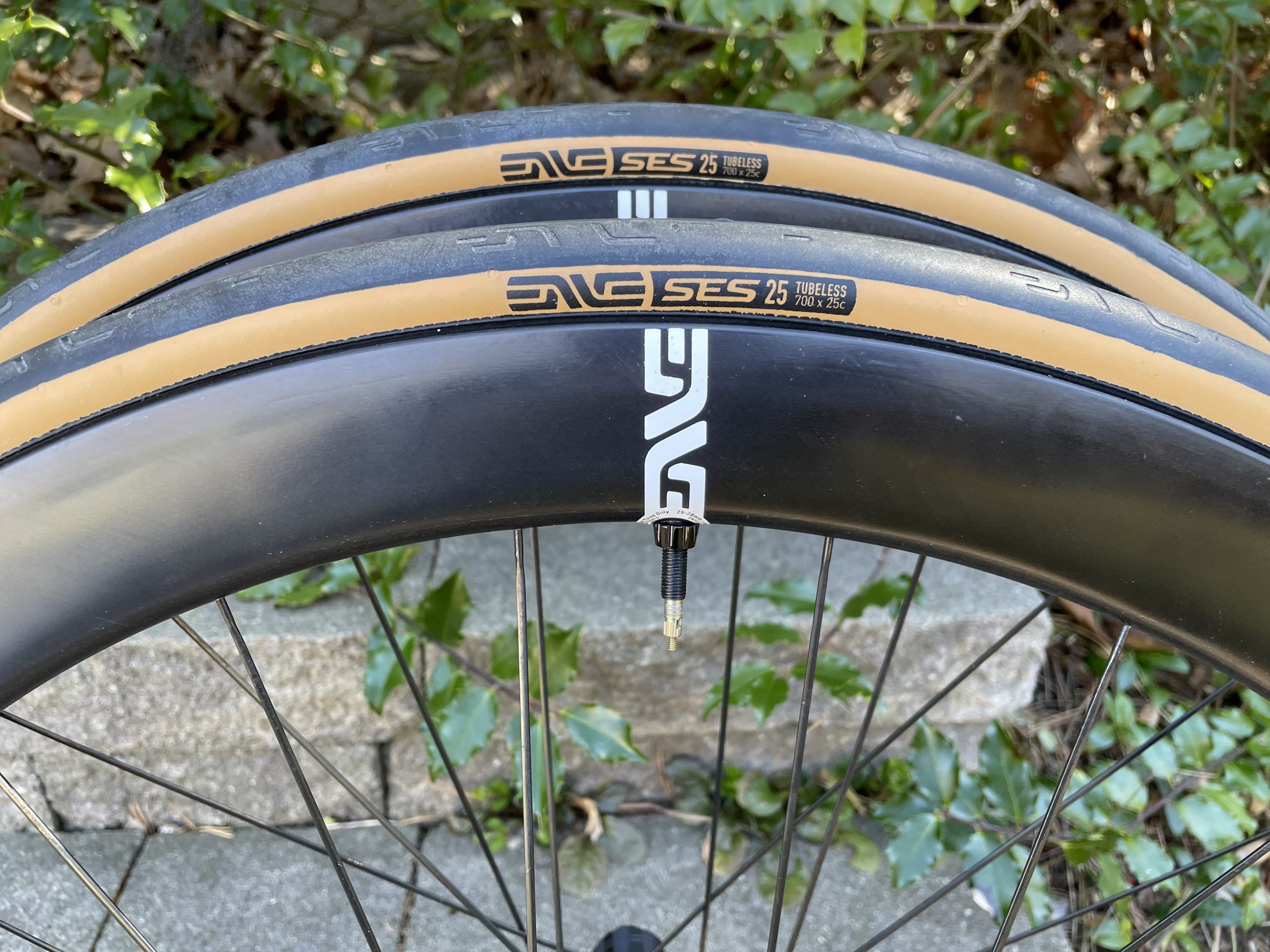ENVE 45 – WELL-PERFORMING VALUE-CARBON WHEELSET

Buying cycling gear or kit is easy when the choice is clear. You need (or, more often, want) something, have an idea of what it should do for you, and don’t want to spend more than a certain amount.
After looking around at what’s out there, one or two options stand out and fit your budget. You make a decision.
Easy.
Unfortunately, buying road bike wheels is anything but easy these days.
Most of us want a carbon road disc wheelset that does nearly everything well, but we can’t find one that also fits our preferred budget. So we either reduce our performance expectations to meet our budget target, increase our budget to hit our performance target or keep looking and waiting for that one wheelset that meets both targets.
Enter the ENVE 45, a US$1400/£2100/€2550 carbon road disc wheelset from the company that makes some of the best-performing wheels my fellow testers and I have ridden.
Before introducing the Foundation road wheel line that now includes the ENVE 45, a deeper ENVE 65 aero road wheelset (reviewed here), two gravel wheelsets, and a MTB one, all ENVE road wheels were part of the high-end crowd I call “performance-carbon” wheelsets. As the category name suggests, it includes the best-performing wheels but they also sell for between US$2000 and US$3000, some more.
At the other end of the range, you have US$1000 to US$1500 value-carbon wheels (reviewed here). In our testing, those give up some performance (e.g., versatility, aerodynamics, responsiveness, comfort, or a combination of the same) and perhaps design preferences (e.g., rim width, freehub noise, finish quality) and brand prestige in exchange for a lower price.
And now there’s the ENVE 45 that sells for US$1400.
While most wheelsets also line up in value-carbon or performance-carbon categories in £ or € denominations, ENVE wheels sell for far more than the exchange rate would suggest when they leave the States for reasons I can’t explain. So at £1800 and €2200, the ENVE 45 lands in the lower end of the performance-carbon price range. Sorry chaps, mates, et mes amis.
So, how does the ENVE 45 rate on the performance and value?
My headline – Comparatively well-performing value-carbon wheelset from a prestige brand.
And, my sub-head – Not on par with the best performance-carbon wheels that cost a good deal more.
You had hoped for better? Me too. I was hoping for a performance-carbon level wheelset at a value-carbon price. The ENVE 45 isn’t it. Sadly, I haven’t found that wheelset anywhere as yet.
Most value-carbon wheels we’ve tested have at least one, and often several, performance weaknesses. They are best when you are willing to compromise away things that really don’t matter as much to you.
So, maybe they aren’t super comfortable unless you put on tires that are wider than the rims. But since you aren’t all about going fast, you trade off some speed for added comfort and better handling at a good price.
Or perhaps they don’t respond with the kind of snap you’d read about from lighter wheels or make it easier going uphill. But since you aren’t racing and know that losing only 2kg (4.4 lbs) in your gut rather than 200 grams in your rims would make you a lot faster and get you to the top of climbs sooner, you pass on paying a grand more for snappy and light wheels that’d be wasted on your rides.
And maybe the price is so attractive that you look away from the warranty that gives you less than a two-year term, or covers only the rims, or makes you pay to ship it to another continent if you want to make a claim after 3 months.
Compared to others in the value-carbon wheelset category, the ENVE 45 Foundation wheels perform pretty well on nearly all of my performance criteria. And they carry the ENVE brand prestige, albeit with rather understated decals on their matte black rims. Those rims are made, and the entire wheelset is assembled in the US, a point of pride and preference for some, and carry a longer-than-most 5-year warranty.
The ENVE 45 is plenty stiff and handles most terrain – flats, rollers, climbs – competently. They aren’t snappy, but neither are they slow off the mark. They don’t favor one type of terrain, like hills, at the expense of another, like flats, or vice versa. They are true “all-arounders”.
Using the same ENVE alloy shell hubs with DT Swiss-like star ratchet internals, the ENVE 45 wheelset rolls smoothly and freewheels relatively quietly while engaging as fast as you need for a road wheelset.
With the right tires, they also handle confidently. Because they use hookless rims, you can’t put every tubeless tire on the ENVE 45. But, per ENVE’s approved tire list (see here), you can use most, including many I’ve reviewed and favor (see here).
If you are committed to using 28mm wide tires, know that the Continental Grand Prix 5000 S TR and Schwalbe Pro One TLE will be two of the most aero choices among those I’ve tested once mounted and inflated to my test pressure of about 60psi will measure about the same width as the rims. And since these are hookless rims, the tire-rim intersection will be a bit smoother than one with hooks, so it won’t likely have a big, negative aero effect.
More importantly, I rode the ENVE 45 with a few different 25mm tires mounted at different pressures and couldn’t find a comfortable combination. While as fast or faster than most of the value carbon wheels of similar depth, these ENVE Foundations didn’t offer the amount of added momentum or free-speed of performance-carbon wheels of similar depth or the deeper value-carbon, 50mm deep Bontrager Aeolus Pro 5 TLR (now discontinued).
The ENVE 45 also got pushed around a bit in the heavy spring crosswinds we have in the Northeast US. Surprising for an ENVE wheelset but not much different than many value-carbon wheels.
If you are a multi-surface rider, know these aren’t gravel wheels. With a 21mm internal rim width, they really aren’t wide enough for more than smooth dirt roads where you’d use a 32mm wide tire at most. ENVE makes the AG25 (review here) which is a dedicated gravel wheelset in their $1400 Foundation range. Those have a 25mm internal rim width that supports gravel tires as wide as 45mm for the kind of comfort and handling you’d want on any gravel class.
Compared to better all-around wheels in the more expensive performance-value category, the ENVE 45 doesn’t compete. They aren’t as responsive, don’t hold their speed as well, aren’t as impervious to crosswinds, don’t climb or handle any better, and are generally less compliant (comfortable).
But, you may be wondering, how is this possible? After all, this is an ENVE wheelset!
Well, I’m not an ENVE wheel designer or product manager and don’t speak for the company (or republish their media talking points as part of my reviews). I will note, however, that they don’t use the same carbon layup, more bulbous front rim shape, and different front and rear widths and shapes on the ENVE 45 as they do on their performance-carbon road wheelsets.
Their most popular road wheels, the ENVE SES 4.5 and 3.4, also have a 25mm internal rim width that makes them versatile enough for road and gravel and, along with their superior carbon layup, more comfortable.
And hey, if they were to make the $1400 ENVE 45 wheelset perform as well as their $2850 and up performance-carbon wheels, they wouldn’t give those of us willing to pay for top performance a reason to do so.
But, if you are looking for a value-carbon wheelset that does most everything as well or better as others in this category, carries a bit of brand prestige and a superior warranty, and you are willing to pay a few hundred more for all of that, then the ENVE 45 is a good choice.
Check the ENVE 45 wheelset pages using links to BTD (BikeTiresDirect) 10% off w/code ITK10, Competitive Cyclist, Performance Bike, Merlin, and Sigma Sports.
In The Know Cycling is ad-free, subscription-free, and reader-supported. If you want to help keep it rolling without any added cost to you, buy your gear and kit after clicking the store links on the site. When you do, we may earn an affiliate commission that will help me cover the expenses to create and publish our independent, comprehensive, and comparative reviews. Thank you, Steve. Learn more.



Hi Steve, thanks for the review – I was waiting for it! Would you say that these slot in between the Zipp 303S and the Zipp 303 Firecrest price and performance-wise? If so, curious if the flat pavement performance (aero and responsiveness) was closer to the 303S or 303 Firecrest? Trying to decide between them – I’m close to your height and weight, mostly flat riding, exclusively paved roads.
Grant, Prices aside the wheels are suited for different types of riding. The 303 Firecrest Disc is a multi-surface wheelset (paved and unpaved) that is best on long, steep climbs but unremarkable on flats compared to other wheels at a similar price. The 303 S and ENVE 45 are more all-around road wheels that aren’t well suited for unpaved or gravel but don’t excel in any one discipline (e.g. climbing or flats) compared to other options at similar price points. If you are riding flat pavement and looking for aero performance at this price, I’d look at the ENVE 65 as a better option than any of the wheels you listed (my review here). Steve
Thanks Steve – I struggle maintaining aero speeds over my rides (25-26 km/h avg) but I do appreciate the feeling of a light, responsive bike, which is why I was considering 40-45mm rims. While aero is a consideration, my priority is responsiveness and handling. These would be going on an Aethos. Would that change your recommendation?
Grant, sorry my friend. While I’m happy to tell you about the strengths and weaknesses of different wheels as I do in my reviews and response to questions, I can’t get into recommending wheels for a reader’s specific riding speeds, terrain, performance preferences, bike, budget, etc. Too many readers, too little time. I did write this post which will help guide you to the best wheels to choose from based on your answers to a dozen questions about your riding profile, goals, and budget. Give that a try. Cheers, Steve
Thanks for the very thorough reviews Steve, keep up the good work ?. Was wondering how you would compare performance of these foundation 45’s the the Zipp 404 Firecrests you also recently reviewed?
Andrew, what are you looking to compare about the two wheelsets? Steve
Probably their “all-round” ability? Is one better for climbing, holding flat ground speed and stiffness?
Andrew, I’d say they are roughly equivalent on stiffness and climbing while the Zipp will be easier to hold your speed on the flats once you get going faster than 20mph/32kph. My full review of the Zipp 404 Firecrest says more about it. Steve
Thanks Steve
Hey Steve, I finally bought myself a new bike that came with these wheels, albeit with the incredibly loud (obnoxiously so) Industry 9 101 hubs, and after only a few rides I’ve more or less come to the same conclusions as you. While I’m sure these are excellent for stock wheels I can’t help but wonder how much difference a better set would make on my bike. I’ve been looking at the Enve SES 4.5 ARs (among others) since I can’t afford the 454 NSWs (maybe someday) and they seem to be the best option for my normal riding conditions, while I strictly stay on paved roads there are some brutal sections in my area that are likely worse than gravel. Would you consider the differences between the 45s and the 4.5 ARs to be very noticeable? I’m trying to justify spending the extra money and selling the 45s to The Pro’s Closet.
Steve, without knowing your rider profile, it’s hard to say how much a difference between the two (other than the audible difference). If you’re the stereotypical cycling enthusiast riding at 18mph+ average speeds, the difference between the ENVE 4.5 AR (my comparative review here) and others even costing around the same amount is quite noticeable and the reason why I’ve rated it a best performer for many years. If you’re more of a weekend warrior and riding slower and on decent roads, you probably won’t appreciate the differences.
You also might want to get your Industry 9 rear hub greased up and see if that lowers the volume. Like many others (notably Chris King, the newest DT Swiss EXP hubs, and those used on Hunt, Scribe, and other low price wheels sold by brands that contract out many functions of their wheelset business), I9 freehubs let you know they’re there when you coast. Some are just loud while others have a lower volume and distinct sonic profile which those who prefer audible freehubs seek out. I’d typically put I9 hubs in the latter category. Sometimes, greasing up the rear hub can lower the volume and allow that profile to come through.
Then again, if you’re like me and like a quiet hub, the ENVE alloy hubs on the ENVE 4.5 AR and other ENVE 45 wheels are pretty quiet. Steve
To keep our independent reviews and comment responses rolling, consider buying your gear after clicking on the store links you see in our reviews. When you do, we may earn a commission that helps cover site costs. Thanks.
Thanks for the quick response, I do typically average 18.5 mph on the flatter routes and ride about 5000 miles per year. This was on an aluminum frame with shallow wheels so basically no aerodynamic assistance there, I expect to be a bit faster with the new bike but naturally I want to squeeze every last bit of speed out of it. I have read the review of the 4.5 AR and it is very enticing, it’s crazy to think they’ve been around since 2016 – Enve was way ahead of the curve and other brands are still playing catch up it seems.
I suppose I could get used to the loud hub but prefer quiet ones, the wheels on what is now my inclement weather bike have whisper quiet Easton hubs that I recently overhauled so it was a shock the first time I heard the I9 hub.
Thanks again Steve for the feedback, I also wanted to thank you for the affiliate link to Power Meter City. I sent my left crank arm in to 4iiii and could not be happier with the power meter, the 10% off certainly was appreciated.
Interesting observations. Still I’m not sure why a less expensive set of wheels would necessarily be more susceptible to cross winds. Can you explain that in more detail? I would think that would be determined by the surface area exposed to the crosswind. Thanks.
Frank, Surface area is certainly a big part of it. However, rim profile plays a bigger role in how wheels deal with a crosswind or sidewind. And typically, companies that do a lot of computer modeling and wind tunnel testing come up with profiles that perform better in winds. They’ll put that profile on their most expensive wheels. Few companies that sell wheels at the >$2000+ price point use the same profile on those wheels and those they sell at <$2000. Enve doesn't. Some companies that only sell wheels <$2000 or in the $1000-$1500 range don't do the extent of R&D to come up with profiles that are as good in the crosswinds as companies that do a lot more R&D.
I wrote more about this and shared data showing how differently wheels of the same depth from different brands perform in side winds in this section of my article How Wide Wheels and Wide Tires Can Make You Faster. Steve